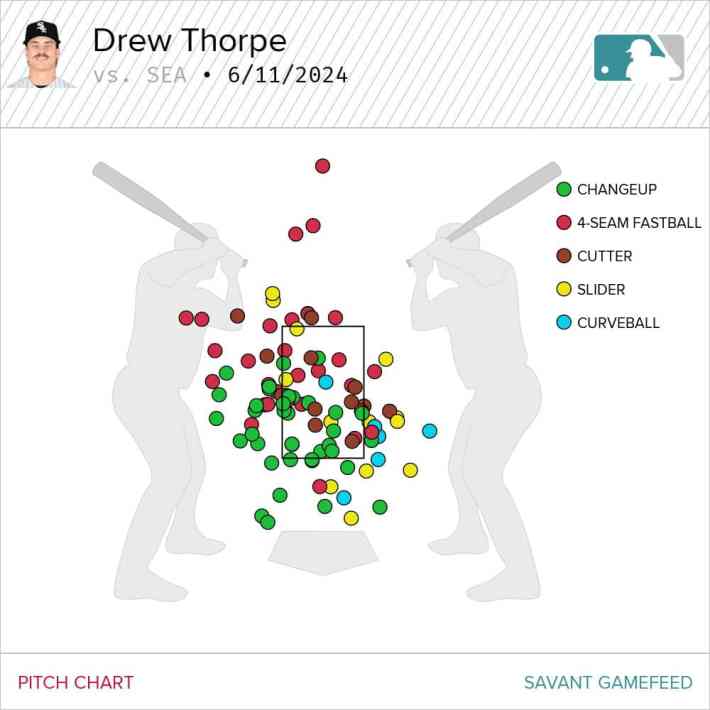What's the least exciting way to characterize Drew Thorpe's MLB debut against the Mariners on Tuesday? Results-wise, it looked an awful lot like Nick Nastrini's back on Jackie Robinson Day.
- Thorpe: 5 IP, 3 H, 2 R, 1 ER, 2 BB, 4 K, 0 HR, 62.2% strike percentage
- Nastrini: 5 IP, 3 H, 2 R, 2 ER, 2 BB, 5 K, 1 HR, 64.8% strike percentage
To those who haven't closed out the tab, here's where I'll note that watching Thorpe didn't remind me of watching Nastrini, mostly because Nastrini walked 23 batters over the 19⅔ innings that followed, making it difficult to remember the version that wasn't always rowing against the current.
It only came to mind afterward, as Thorpe's postgame reaction in defeat ...
The White Sox bullpen couldn’t hold the lead for a second consecutive night, giving up the deciding two runs in the bottom of the seventh, but Thorpe’s presence was felt in the clubhouse afterward despite the result, and Thorpe was still floating from a dream realized and a good first impression.
"I can’t really put it into words, honestly,” Thorpe said of the experience. “It’s my dream come true, and it was good to get the first one out of the way.”
... reminded me of Nastrini sounding extremely pleased about his experience while the White Sox lost 2-0.
And there's nothing wrong with that. The White Sox fell to 17-51 after losing a game they led for the 25th time this year, so personal triumphs are the best thing going. Five innings of two-run ball in a big-league debut -- especially around some shoddy infield defense on routine plays -- counts as such.
Watching Thorpe against MLB competition, it's easy to see why he's such a divisive prospect. His changeup is indeed a major-league pitch, and he threw it more than any other pitch (38, compared to 28 fastballs, 13 sliders, 13 cutters and six curves). He had no problems using it righty-righty, and one of them resulted in a strikeout of Julio Rodríguez for Thorpe's first career K. He said he gave the ball to his mom.
When Thorpe shows immaculate command like he did in the first inning, his recipe for success is very simple. When his location loosens and the counts aren't as regularly in his favor, it's a little harder to understand how it works. The fastball is low-90s, the slider has some sharpness, but isn't overpowering. Two swinging strikes he got on that pitch -- although one was re-classified to a cutter -- were ones that backed up on him.
The question is whether the changeup is so good that the mere threat of it allows everything else to play up a little bit, provided the command is there, or that the misses are harmless. He didn't have his best control on Tuesday, but he still avoided spending too much time over the heart of the plate.

He also helped out his cause with his defense. He opened the game by covering a 3-1 putout with plenty of time to spare, and he closed it out with sensational coverage of Cal Raleigh's swinging bunt in the fifth inning.
Depending on the characteristics of a major leaguer you trust the most, Thorpe could find adjustments difficult to make once the league gets more accustomed to his changeup and his willingness to throw it. He could also be one of those pitchers whose sum is greater than the parts, because while plus command in the minors often deteriorates under the stress of big league competition, sometimes it holds up just fine, and priors have to be revisited.
What's more apparent in the interim is that the White Sox didn't err in judgment by promoting Thorpe directly from Birmingham. He looked adequately prepared for the challenge, and the context of the roster doesn't hurt him either. The White Sox rotation features a couple other righties whose stuff doesn't jump off the screen, but they've still been able to get batters out for games, weeks, and/or months at a time. Subsequent starts will tell us whether he's closer to Erick Fedde or Chris Flexen on the spectrum, but at this stage in his career, he can take pleasure in being compared to either.






